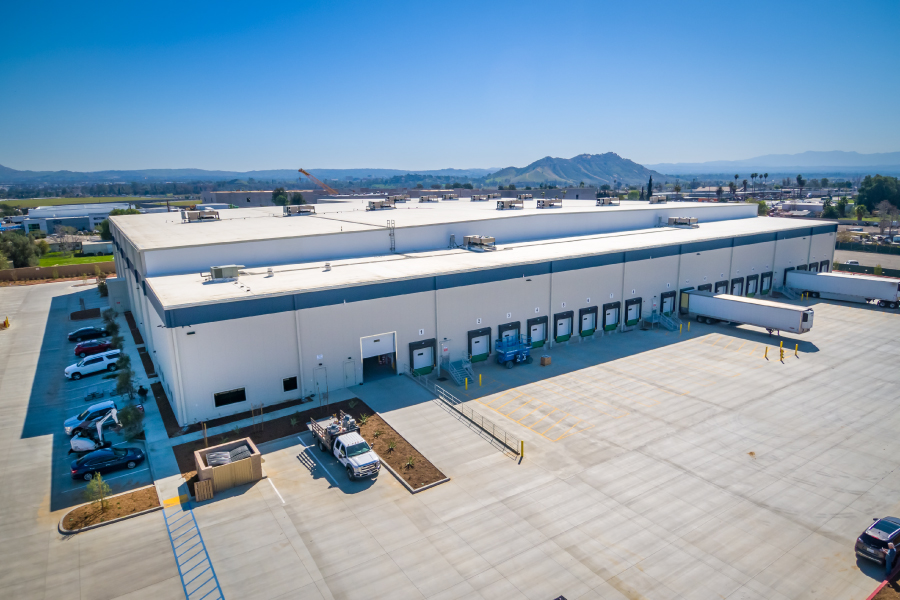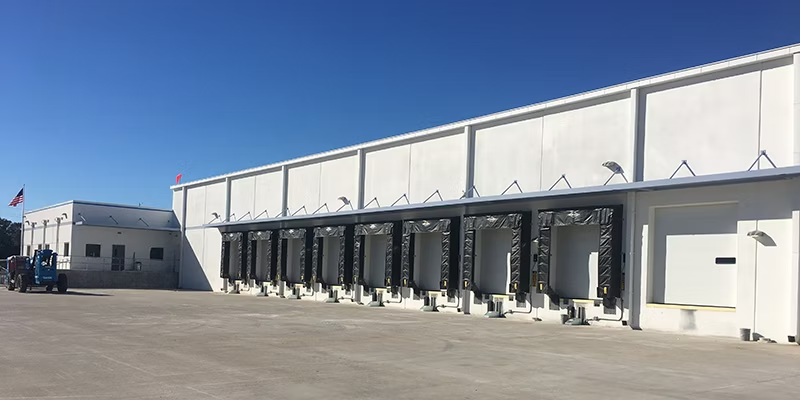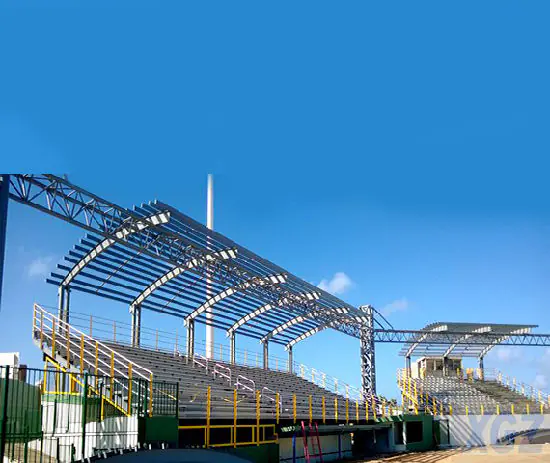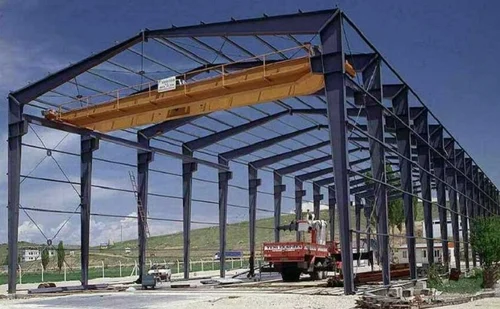Cold Storage Warehouse Construction Specs: Complete Guide
Learn cold storage warehouse construction specs, benefits, and management tips. A comprehensive guide to building efficient cold storage facilities.
Cold storage warehouses are vital facilities in modern supply chains, especially for food, pharmaceutical, and temperature-sensitive product industries. This article comprehensively discusses what cold storage warehouses are, their construction specifications, various benefits, and effective management tips.
From types of cold storage to the latest refrigeration technologies, we explore all important aspects of building and operating efficient cold storage warehouses. Discover how to increase productivity, maintain product quality, and optimise your supply chain logistics with the right cold storage facility.
1.What is a Cold Storage Warehouse?
A cold storage warehouse, or cold storage facility, is a specialised structure designed to store products that require low temperatures to maintain their quality and freshness. These facilities play a crucial role in modern supply chains, especially for industries that rely on temperature-controlled storage.
Here are some main types of products typically stored in cold storage warehouses:
1.1 Food Products
Cold storage warehouses are essential for the food industry. Products such as fresh meat, fish, dairy products, fruits, and vegetables require low temperatures to prevent spoilage and maintain freshness. Frozen foods, like ice cream and ready-to-eat meals, also require storage at very low temperatures.
1.2 Flowers and Plants
The flower and ornamental plant industry also utilises cold storage warehouses. Low temperatures help slow down the ageing process of flowers, extend shelf life, and maintain freshness before sale or delivery to consumers.
1.3 Artworks
Some types of artwork, especially those made from organic materials or sensitive to temperature and humidity, are often stored in specialised cold storage facilities. This helps prevent damage and maintain the quality of the artwork in the long term.
1.4 Pharmaceutical Purposes
The pharmaceutical industry heavily relies on cold storage warehouses. Many medicines, vaccines, and biotechnology products require storage at specific temperatures to maintain their effectiveness. Improper storage can result in product degradation and reduced efficacy.
1.5 Temperature in Cold Storage Warehouses
Temperatures in cold storage warehouses vary depending on the type of products stored. Generally, temperature categories in cold storage warehouses include:
- Chilling: Temperatures between 0°C to 10°C, ideal for fruits, vegetables, and dairy products.
- Freezing: Temperatures below 0°C, typically -18°C or lower, for frozen products like meat and ice cream.
- Ultra-Low Temperature: Very low temperatures, can reach -70°C or lower, used for storing certain vaccines and biological samples.
Cold storage warehouses are equipped with advanced cooling systems that can maintain constant temperatures according to product requirements. Additionally, these facilities also have humidity control systems to prevent ice formation and maintain product quality.
In their construction, cold storage warehouses require excellent insulation to maintain energy efficiency. Walls, floors, and roofs are usually coated with high-quality insulation materials to prevent heat transfer from the outside environment.
A good understanding of the temperature needs of various products is crucial in managing a cold storage warehouse. This ensures that each product is stored at its optimal temperature, maintaining its quality and extending its shelf life.

2.Cold Storage Construction
The construction of a cold storage warehouse is a complex process that requires careful planning and execution. Here are important aspects of cold storage warehouse construction:
2.1 Types of Cold Storage
- Blast Freezers: Designed to freeze products quickly, typically used for fresh food products.
- Chiller Rooms: For storing products at temperatures above freezing, usually between 0°C to 10°C.
- Freezer Rooms: For storing frozen products at temperatures below 0°C.
- Controlled Atmosphere Storage: Besides temperature, also controls oxygen and carbon dioxide levels, ideal for certain fruits and vegetables.
2.2 Refrigeration
The refrigeration system is the heart of a cold storage warehouse. Some important aspects include:
- Type of Refrigerant: Use of environmentally friendly refrigerants such as ammonia or CO2 is becoming increasingly popular.
- Compressor: Selection of efficient compressors suitable for the warehouse capacity.
- Evaporator: Important for even distribution of cold air.
- Condenser: For dissipating heat from the system.
- Control System: Automation for energy efficiency and precise temperature control.
2.3 R-Value and Temperature Control
R-Value refers to the insulation capacity of materials. The higher the R-Value, the better the insulation.
- Walls and Roof: Typically use sandwich panels with polyurethane or polystyrene foam.
- Floor: Requires special insulation to prevent ground freezing underneath.
- Doors: Special doors with good seals to prevent cold air leakage.
- Temperature Monitoring System: Use of sensors and real-time monitoring systems to maintain constant temperatures.
2.4 Building Structure
- Foundation: Must be strong to support the heavy load of products and equipment.
- Frame: Can use steel or precast concrete, depending on size and requirements.
- Roof: Must be able to withstand snow loads (if relevant) and HVAC equipment.
2.5 Electrical System
- Backup Power: Backup generators to maintain operations during power outages.
- Lighting: Use of energy-efficient LED lights that can withstand low temperatures.
- Control System: Advanced control panels to manage all aspects of operations.

2.6 Security System
- Temperature Alarms: To warn if temperatures deviate from the specified range.
- Sprinkler System: Specially designed for low-temperature environments.
- Ammonia Leak Detection System: If using ammonia as a refrigerant.
2.7 Ventilation System
- Air Exchange: Important to prevent accumulation of ethylene and other gases.
- Dehumidifier: To control humidity and prevent ice formation.
2.8 Loading Dock Area
- Dock Seal: To prevent outside air from entering during loading/unloading.
- Leveler System: To adjust truck height with warehouse floor.
2.9 Floor
- Abrasion Resistant: To withstand intense forklift traffic.
- Low Temperature Resistant: Special materials that don’t crack at low temperatures.
- Slope: Slight slope for drainage during defrosting.
2.10 Warehouse Management System
- Storage Racks: Tailored to the type of products and material handling system.
- Tracking System: RFID or barcode for inventory tracking.
2.11 Energy Efficiency
- Additional Insulation: Around pipes and cooling system components.
- Heat Recovery System: To utilise waste heat from the refrigeration system.
- Automatic Doors: To minimise cold air loss.
Construction of a cold storage warehouse requires specialised expertise and collaboration between various disciplines, including mechanical engineering, civil engineering, and electrical engineering. Careful planning and selection of appropriate materials and technologies are crucial to creating an efficient and effective cold storage facility.
3.Cold Storage Warehouse Benefits
Cold storage warehouses offer several significant benefits for modern industries and supply chains. Here’s a detailed explanation of the main benefits:
3.1 Prevents Product Damage
- Extends Shelf Life: Low temperatures slow down bacterial growth and decay processes, allowing products to last longer.
- Maintains Nutrition: For food products, cold storage helps maintain nutritional value and vitamins.
- Prevents Physical Changes: Avoids changes in texture, color, and taste in temperature-sensitive products.
- Reduces Waste: By extending shelf life, cold storage warehouses help reduce food and other product waste.
3.2 Creates Employment
- Direct Job Opportunities: Requires workforce for operations, maintenance, and warehouse management.
- Indirect Job Opportunities: Supports related industries such as refrigerated transportation and refrigeration equipment manufacturers.
- Skill Enhancement: Requires skilled labor in cooling technology and cold chain management.
- Local Economic Stimulation: The presence of cold storage warehouses can attract related businesses to the area.
3.3 Enhances Productivity
- Operational Efficiency: Organised storage and handling systems increase work efficiency.
- Better Inventory Management: Advanced tracking and inventory management systems allow for better stock control.
- Reduces Losses: By minimising product damage, overall productivity increases.
- Flexibility in Production: Allows for large-scale production and storage for future use.
3.4 Eases Supply Chain Logistics
- Supply Stabilization: Allows storage of seasonal products for use throughout the year.
- Increased Market Reach: Products can be stored longer, allowing distribution to more distant markets.
- Demand Fluctuation Management: Helps address imbalances between production and demand.
- Integration with E-commerce: Supports rapid delivery for products requiring temperature control in electronic commerce.

3.5 Food Safety
- Maintains Quality: Proper temperature helps maintain the quality and safety of food products.
- Prevents Contamination: Controlled environment reduces the risk of cross-contamination.
- Tracking and Traceability: Modern management systems allow product tracking from source to consumer.
3.6 Storage Flexibility
- Multi-temperature Zones: Allows storage of various types of products with different temperature needs in one facility.
- Scalability: Can be adjusted to meet increased or decreased storage demand.
3.7 Regulatory Compliance
- Meets Industry Standards: Helps businesses comply with food safety and pharmaceutical regulations.
- Documentation: Temperature monitoring systems provide records necessary for audits and inspections.
3.8 Long-term Cost Reduction
- Energy Efficiency: Modern technology allows for long-term reduction in energy consumption.
- Loss Reduction: Reducing losses due to product damage can result in significant savings.
3.9 Support for Product Innovation
- New Product Development: Allows experimentation with products requiring temperature-controlled storage.
- Product Line Expansion: Businesses can expand into products previously impossible due to storage limitations.
By understanding and leveraging these benefits, businesses can optimise their operations, increase efficiency, and open new opportunities in competitive markets.
4.Tips for Managing a Cold Storage Warehouse
Effective management of a cold storage warehouse requires special attention to various aspects. Here are some important tips for optimally managing a cold storage warehouse:
4.1 Strict Temperature Monitoring
- Use automatic and real-time temperature monitoring systems.
- Set alarms for temperature deviations outside specified limits.
- Perform routine calibration on temperature sensors.
4.2 Layout Optimization
- Organize products based on required storage temperatures.
- Use appropriate rack systems to maximize vertical space.
- Ensure sufficient space for air circulation.
4.3 Employee Training
- Provide regular training on safety procedures and product handling.
- Educate employees about the importance of maintaining consistent temperatures.
- Train staff in the use of low-temperature specific material handling equipment.
4.4 Preventive Maintenance
- Conduct routine checks on the cooling system.
- Clean evaporators and condensers regularly.
- Check door seals and repair immediately if there’s damage.
4.5 Efficient Inventory Management
- Implement a First-In-First-Out (FIFO) system for stock rotation.
- Use technologies like RFID or barcodes for inventory tracking.
- Conduct periodic inventory audits.
4.6 Energy Optimization
- Use energy-efficient LED lights.
- Install air curtains or automatic doors to reduce cold air loss.
- Consider using heat recovery systems.
4.7 Safety and Security
- Install security systems such as CCTV and access control.
- Provide appropriate personal protective equipment for employees.
- Conduct regular emergency evacuation drills.
4.8 Contamination Management
- Implement strict sanitation procedures.
- Separate storage areas for different types of products.
- Use easy-to-clean pallets and containers.
4.9 Documentation Management
- Maintain accurate temperature records.
- Document all standard operating procedures.
- Keep maintenance and repair logs.
4.10 Capacity Planning
- Monitor warehouse utilisation levels regularly.
- Plan for seasonal fluctuations in storage demand.
- Consider expansion or outsourcing options if necessary.
4.11 Emergency Handling
- Have backup generators to anticipate power outages.
- Develop contingency plans for cooling system failures.
- Prepare contracts with emergency service providers.
By implementing these tips, cold storage warehouse managers can improve operational efficiency, maintain product quality, and ensure compliance with industry standards and regulations.
5.Conclusion
Cold storage warehouses are vital components in modern supply chains, especially for industries handling temperature-sensitive products. From complex construction to careful management, every aspect of a cold storage warehouse is designed to ensure optimal product storage.
The main advantage of cold storage warehouses lies in their ability to extend product shelf life, maintain quality, and enable wider distribution. This not only benefits producers and distributors but also consumers who gain access to high-quality products year-round.
However, managing a cold storage warehouse is not an easy task. It requires a deep understanding of cooling technology, energy management, and proper product handling practices. Compliance with strict regulations and industry standards is also a critical aspect that should not be overlooked.
With ongoing technological developments, the future of cold storage warehouses promises increased efficiency and sustainability. Innovations in environmentally friendly cooling systems, automation, and Internet of Things (IoT) integration will continue to drive the evolution of this industry.
For businesses that rely on temperature-controlled storage, investment in proper cold storage warehouse facilities and management practices can be a significant differentiating factor in a competitive market. By understanding and implementing best practices in cold storage warehouse construction and management, companies can improve operational efficiency, maintain product quality, and ultimately, increase customer satisfaction and profitability.



Post Comment